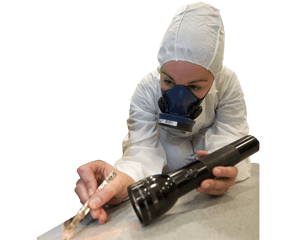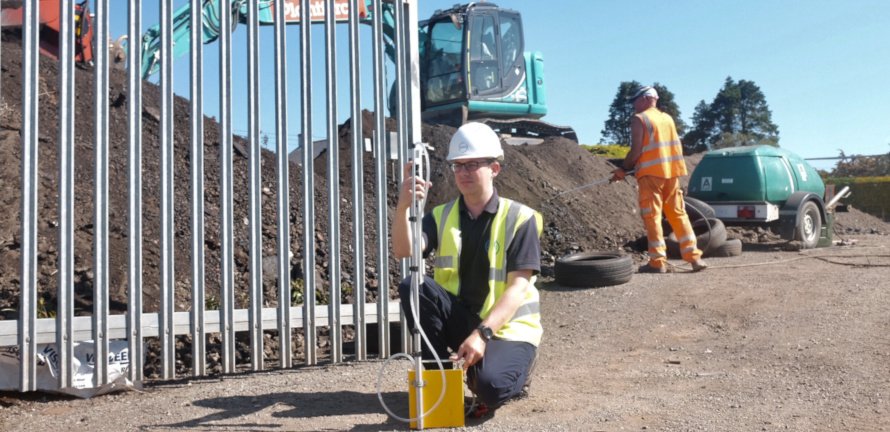Up to: < Air monitoring
Do I Need an Asbestos Air Test?
A common question for homeowners.

Reasons why you may ask: do I need an asbestos air test?
Following an asbestos disturbance or removal project, air testing may be needed. You, your insurance company or asbestos removal contractor can commission this work.
What type of air test will best suit you?
There is a range of air testing services that can protect you and your family. The most appropriate test will be dependent upon your individual situation. Factors that will affect this include:
- What has happened in the past. Has asbestos been disturbed within your home?
- The type of asbestos present and the material it is contained within.
- Has an asbestos removal project been completed within your home? If yes, what type?
The above factors are not exhaustive but will affect the type of test most suited to your needs.

The tests explained
Background air testing
If an asbestos removal contractor intends to clean up or remove asbestos from your property, they may require a background air test. This test is completed before their work commences. It involves sampling a known volume of air through a filter using a sampling pump. After the analyst has collected the sample, they count the fibres present on the filter. This confirms the concentration of asbestos fibres within the air. This measurement can be used as a baseline to compare later test results to. It can confirm if removal or remediation works lead to increased asbestos fibre levels.
Reassurance air testing
If asbestos has been disturbed or removed, you may need a reassurance air test. An asbestos reassurance air test is exactly the same as a background test. The only point of differentiation is the timing of the tests. Reassurance air tests are completed after asbestos has been disturbed or removed. It indicates whether your home is safe to occupy (subject to the fibre count obtained).
Reassurance air testing often follows planned, non-licensed asbestos removal projects. It is generally considered that a test result of <0.01 f/ml (below 0.01 fibres per ml of air) is safe and you can safely occupy your home.
Visual inspection
If asbestos has been disturbed or removed, a visual inspection may be needed. It involves having a qualified, experienced analyst, inspecting, by eye, the areas of asbestos of removal at your home. This test will ensure that all remains of asbestos have been removed.
Visual inspections often follow non-licensed asbestos removal projects. The report issued states clearly whether the area has passed or failed the inspection.
Four stage clearance
A four stage clearance is a legal requirement following a licensed asbestos removal project. These projects involve removing asbestos under fully controlled conditions within an asbestos enclosure.
As the name suggests it involves four stages:
Stage 1 - Preliminary check of the site condition and job completeness
An analyst will check the scope of work and ensure that the planned works have been undertaken. They will also check the site files. They will make sure that all legally required documents are present and up to date.
They also check that the enclosure is intact, that the decontamination unit (DCU) is operational and the waste and transit routes are clear.
Stage 2 - Thorough visual inspection inside the enclosure
An analyst will inspect the enclosure to make sure that all asbestos containing materials have been removed. The area must also be free from any other dust and debris. In certain situations some asbestos may have to be left in situ. For example, this could be due to structural implications of removal. In such instances an independent analyst should highlight this and make sure that it is suitably encapsulated.
Stage 3 - Air testing
Whilst sampling the air, an analyst should brush the enclosure. This process disturbs any unseen, fine, settled dust which is likely to contain asbestos fibres.
As with the reassurance and background air tests, a known volume of air is pulled through a pump with a filter. The filters are then counted on-site, using phase contrast microscopy.
Providing the air tests pass, with results less than 0.01 f/ml, the enclosure is signed off at stage 3. At this point the removal contractors can then begin to take it down.
Stage 4 - Final assessment (post enclosure)
This is the final check of the removal area. The analyst will ensure that all parts of the enclosure have been removed and that the waste and transit routes are clear.
Once stage 4 is passed and complete, the analyst can issue the certificate of reoccupation. This document confirms that the area is safe to reoccupy.
Who to appoint…
It is essential that you appoint a UKAS accredited analytical firm to complete asbestos air testing. They should be independent from the removals contractor. This helps to ensure that they are unbiased and impartial.
